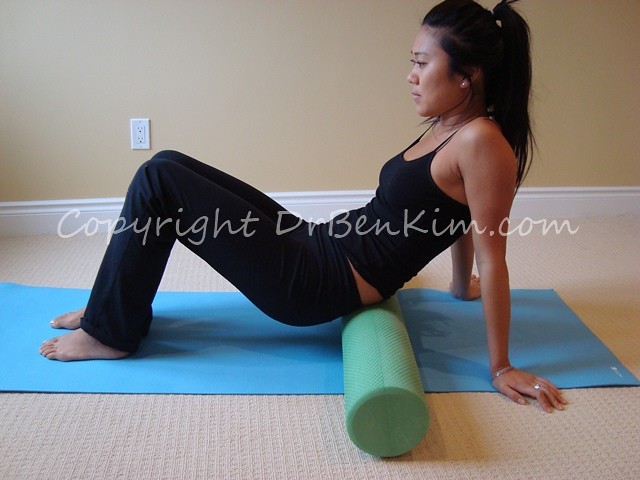You are here
Health Benefits of Foam Rolling
I'm not sure how long foam rollers have been around, but over the past several months, I've discovered how powerful a therapeutic tool they can be for promoting and maintaining optimal physical health.
The idea is simple enough: Using your own body weight and agility, you roll specific muscle groups against a firm foam roller to mimic a deep, gliding massage.
In case you're not sure what a foam roller looks like:
With a foam roller, you can control how much pressure you apply to the tissues that you're working on, and you can locate and focus on areas that are problematic.
I've long been a fan of soft tissue therapies like deep tissue massage, myofascial rolling, and active release technique (ART), and I continue to use and recommend these therapies in many situations. I think of foam rolling as the perfect adjunct to all such therapies. And because you can use a foam roller just about anywhere, you can experience terrific health gains in a relatively short period of time.
As I see it, the main benefits of foam rolling are as follows:
-
Improved blood circulation throughout your skin, fascia, muscles, and even tendons and ligaments where you can access them with a foam roller.
-
Through improved blood circulation, more efficient exchange of nutrients and waste products at a cellular level, leading to better overall cellular function and inter-cellular communication.
-
Lengthening of short (tight) muscles, tendons, and ligaments.
Some muscles (like hip flexors) and ligaments (iliotibial band) are prone to shortening, and are difficult to effectively stretch and apply therapeutic pressure to using standard massage and trigger point therapy techniques. But with a foam roller, you can apply deep pressure massage to such areas and lengthen shortened tissues, thereby preventing physical imbalances that can predispose you to injury.
-
Promotion of optimal spinal range of motion. You can accomplish this by slowly rolling your spine against a foam roller and pausing whenever you feel restrictions to allow your joints and surrounding tissues to stretch.
Beyond using a foam roller as a therapeutic tool, you can also use it for a variety of exercises. It's especially useful for a number of core-strengthening and stabilizing postures and movements.
When we experience physical health challenges like pain and stiffness around weight-bearing joints (hips, knees, and spinal joints), for many of us, the instinct is to get some sort of treatment - if not a conventional pain killer or some invasive surgical procedure, then at least some alternative therapy like acupuncture, chiropractic adjustments, ultrasound, laser, or electrical stimulation.
A less obvious and often times more effective approach is to work at improving blood circulation around the problematic area through deep pressure work and dedicating oneself to stretching the muscles and ligaments around the affected joints.
Sometimes, short/tight muscles and ligaments are the root cause of a joint region becoming dysfunctional and producing pain and stiffness.
This is not to say that various therapies can't be helpful; they can usually help in some way, though to what degree, no one can know for sure.
My point is to consider addressing physical injuries and breakdowns with a dedicated program of soft tissue work and stretching - work that you do multiple times daily on your own. I'm finding more and more that actively working to address physical health challenges in this way can be the magic bullet that many often seek when they're physically distressed.
This makes sense, doesn't it? That you'll make more gains working on a problematic area several times a day than you will getting just one, two, or three treatment sessions per week. Of course, it may be ideal to have both going on when you have an injury, with the work you do on your own supporting the work of a skilled and experienced health practitioner.
Bottom line: foam rolling can be a huge part of any effective program of self-applied deep pressure work and stretching.
If you don't have a foam roller and are looking to invest in one that offers a blend of comfort, durability, and ideal density to provide therapeutic rolling of your muscles and ligaments, please feel free to have a look at the one that I had custom made for our clients here:
For a DVD that presents still photos and video clips that illustrate how to take your body through all of the major stretches and foam rolling exercises you can do to keep your body as healthy as your genetics will allow, have a look here:
Stretching and Foam Rolling DVD, by Sharon Lee and Dr. Ben Kim
Some foam rollers are softer, others are harder. I had ours custom made to provide an optimal balance of firmness and comfort for all major muscle and ligament groups. But please keep in mind that the amount of pressure that is used on any given area is mostly controlled by the amount of pressure you allow your body and gravity to exert.
If you don't know where to start with foam rolling, browse through our archive on stretching and foam rolling here:
For the results that I've seen using the foam roller, both on myself and others, I'm extremely grateful to have stumbled upon this powerful therapeutic tool. If you give it a go, I trust that it will lead to good things.
Note: If you find that you can't access short/tight areas with a conventional foam roller, you may benefit from using a hand-held roller. For areas like the achilles tendon, soleus muscle, and wrist flexors and extensors, the hand-held roller that I like to use can be found here:







